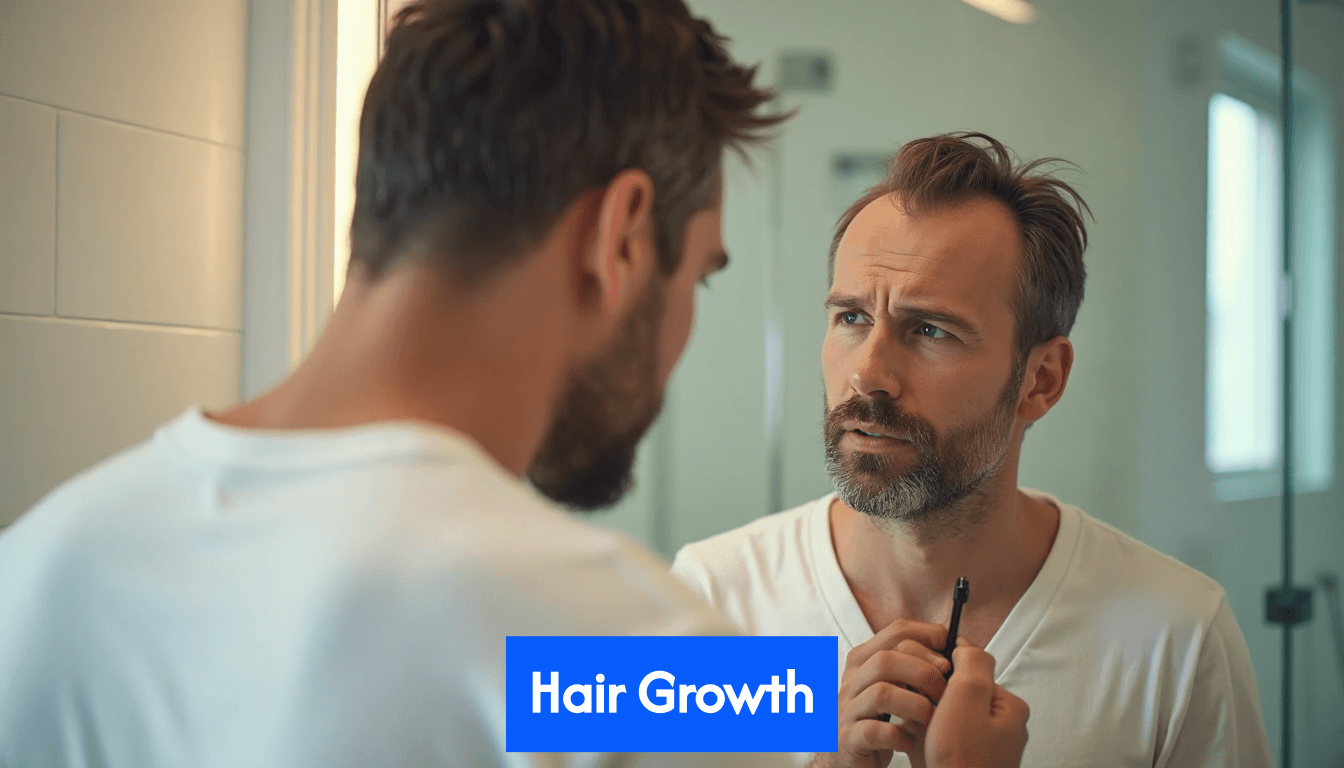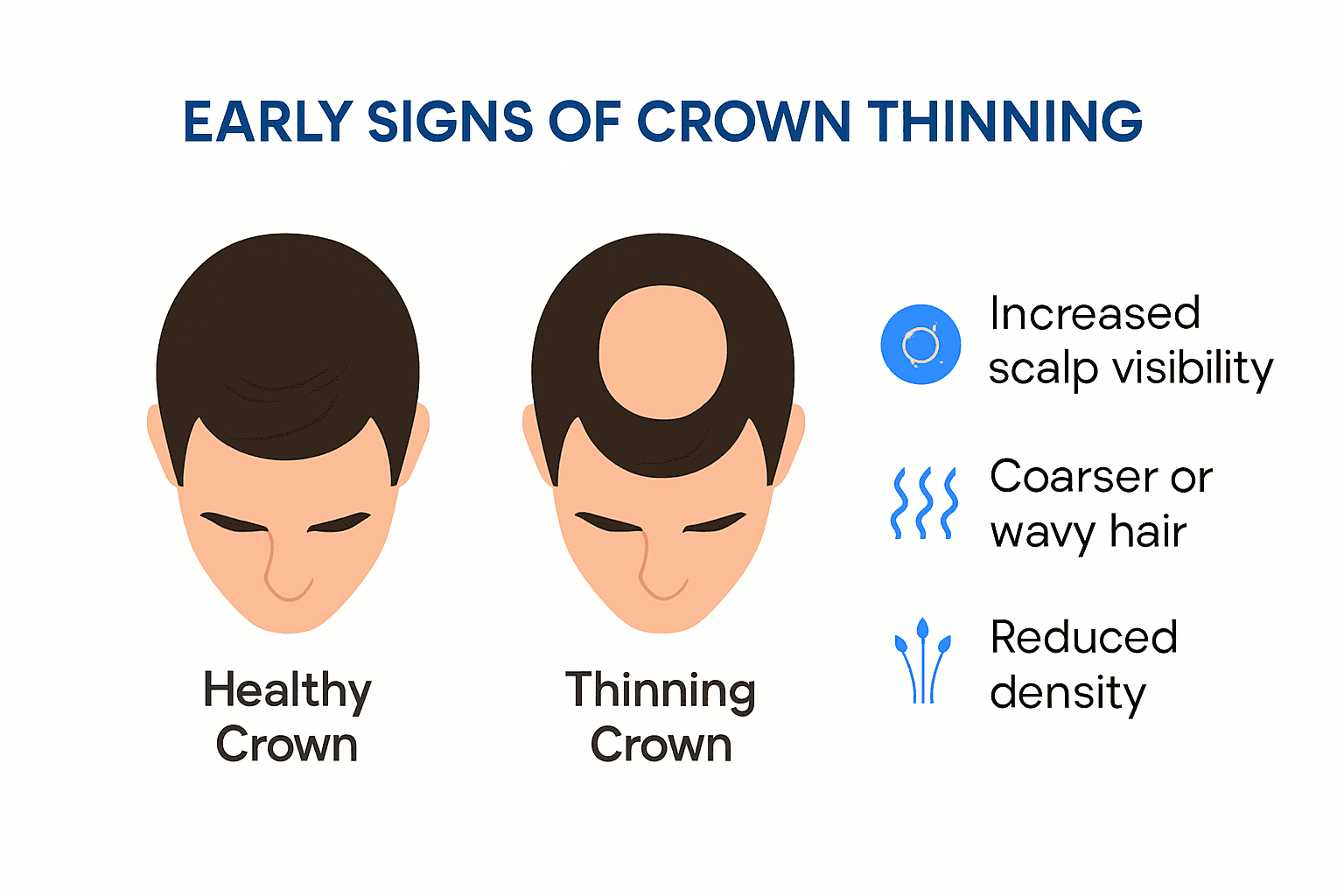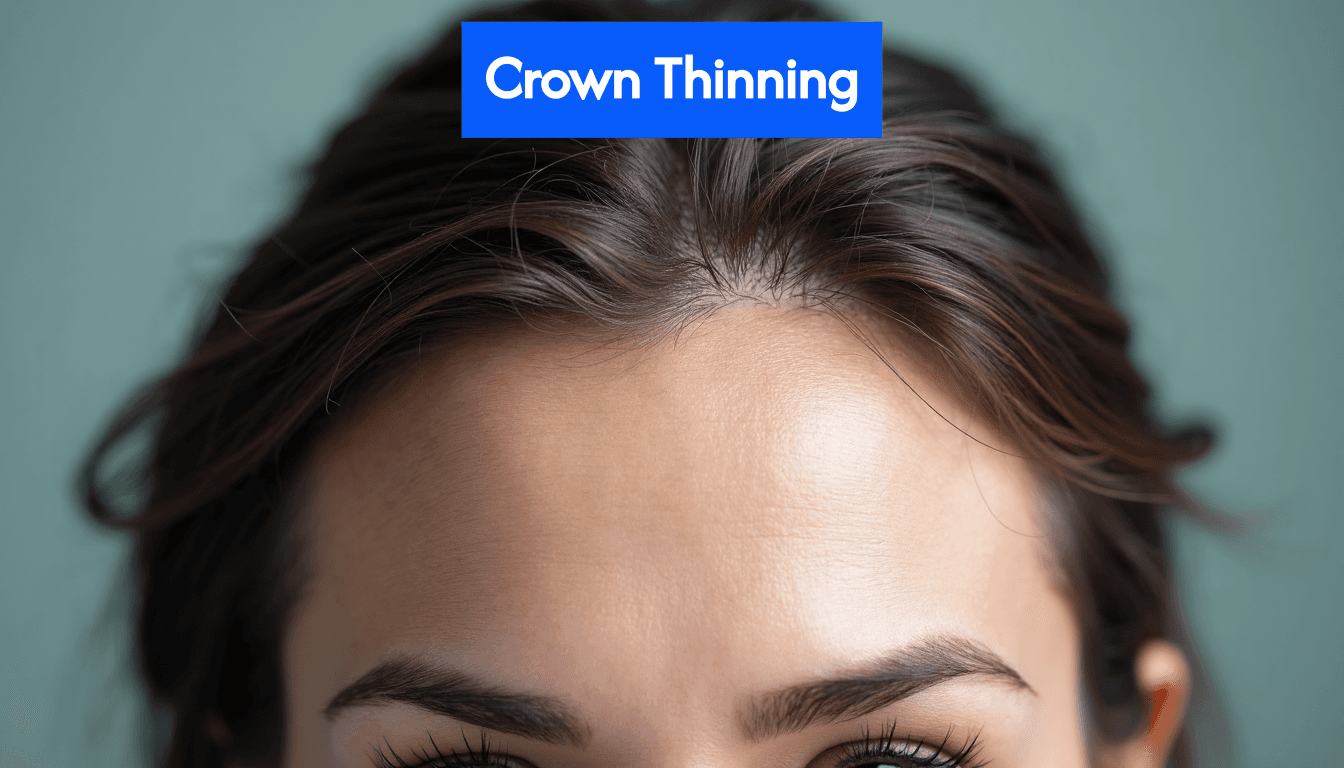Blog
Learning Materials
How to Fix a Bald Spot on Crown of Head: 2025 Hair Growth Guide
Updated: June 17, 2025

Bald spots on the crown are one of the most common hair loss worries for both men and women. Here is something most people miss. Over 50 million Americans will notice a thinning crown at some point, but early signs are often sneaky and easy to overlook. Most expect shiny scalp patches overnight, but what actually happens are subtle changes in texture, density, and scalp visibility that creep in gradually. Spotting them early can mean the difference between fast recovery or months of frustration, and the first clue may appear where you least expect it.
Table of Contents
- Spotting Early Signs Of Crown Thinning
- Top Causes Of Bald Spot On Crown Of Head
- Best Treatments And Hair Growth Solutions
- Tips To Track Progress And Personalize Your Care
Quick Summary
| Takeaway | Explanation |
|---|---|
| Spot Early Signs | Monitor visibility of the scalp, hair texture, and density changes to identify early crown thinning for intervention. |
| Understand Causes | Hair loss can stem from genetic factors, autoimmune conditions, and lifestyle choices, making awareness crucial for management. |
| Utilize Effective Treatments | Combine pharmaceutical treatments (like minoxidil and finasteride), advanced techniques (such as PRP therapy), and holistic approaches to enhance hair growth. |
| Track Progress Systematically | Document hair changes through consistent photography, measurement tools like the Norwood Scale, and professional consultations for personalized treatment optimization. |
| Personalize Your Care | Adapt treatment strategies based on monitoring results and individual responses to interventions, ensuring a tailored approach to hair restoration. |
Spotting Early Signs of Crown Thinning
Recognizing a bald spot on crown of head early can be the key to effective intervention and potential hair restoration. Crown thinning often begins subtly, making it crucial to understand the nuanced signs that signal the onset of hair loss.

Visual Changes in Scalp Visibility
The first indicator of crown thinning is increased scalp visibility. This phenomenon occurs when hair density decreases, allowing more of the scalp to become visible through your hair. Detailed research from Mayo Clinic suggests that this thinning typically follows predictable patterns in both men and women.
To effectively monitor these changes, consider these strategic observation techniques:
- Photography Comparison: Take periodic top and back of head photos under consistent lighting. Compare these images over time to track subtle density changes.
- Lighting Assessment: Use bright, direct lighting and a hand mirror to examine your crown. Increased light reflection on the scalp indicates potential thinning.
- Hairstyle Impact: Notice if your usual hairstyle no longer covers areas it previously did, suggesting reduced hair volume.
Texture and Hair Strand Changes
Beyond visual scalp exposure, subtle texture modifications can signal impending crown thinning. Hair strands may become progressively thinner, more fragile, and less robust. According to research from New Beauty, these microscopic changes often precede significant hair loss.
Key textural indicators include:
- Reduced hair strand diameter
- Increased hair breakage during brushing or styling
- Diminished hair elasticity and strength
- Noticeable decrease in overall hair volume

Tracking Progression and Taking Action
Careful monitoring provides the best defense against progressive crown thinning. Using multiple observation methods creates a comprehensive tracking approach. Experts at Avantus Clinic recommend establishing a systematic assessment routine.
Consider implementing a monthly self-examination process:
- Photograph your crown from multiple angles
- Measure hair density using standardized techniques
- Document any observed changes
- Consult a professional if consistent thinning is detected
Understanding these early signs empowers individuals to seek timely interventions. While crown thinning can feel distressing, modern treatments offer promising solutions for hair restoration and management. Proactive observation combined with professional guidance can significantly mitigate potential long term hair loss progression.
Top Causes of Bald Spot on Crown of Head
Understanding the underlying mechanisms behind a bald spot on crown of head requires a comprehensive exploration of multiple potential factors. The development of crown hair loss is rarely the result of a single cause but often emerges from a complex interplay of genetic, physiological, and environmental influences.
Genetic and Hormonal Triggers
Research from the National Center for Biotechnology Information reveals that androgenetic alopecia represents the most prevalent cause of crown hair loss. This condition is fundamentally rooted in genetic predisposition and hormonal interactions, particularly involving dihydrotestosterone (DHT).
Key genetic and hormonal factors include:
- Inherited Sensitivity: Genetic variations can make hair follicles more susceptible to hormonal changes
- Testosterone Conversion: DHT shrinks hair follicles, gradually reducing hair growth potential
- Familial Pattern: Crown baldness often follows inherited genetic blueprints
Male individuals with a family history of baldness are significantly more likely to experience crown hair loss. The genetic component determines both the likelihood and potential progression of hair thinning.
Autoimmune and Health Conditions
According to the American Academy of Dermatology, multiple health conditions can contribute to unexpected crown hair loss. Autoimmune disorders represent a critical category of potential causes that directly impact hair follicle functionality.
Significant health-related contributors include:
- Alopecia Areata: An autoimmune condition where the immune system attacks hair follicles
- Thyroid Disorders: Hormonal imbalances that disrupt normal hair growth cycles
- Lupus: Systemic inflammatory conditions that can cause localized hair loss
- Scalp Infections: Fungal or bacterial infections potentially damaging hair follicles
Lifestyle and Environmental Factors
Beyond genetic and medical factors, lifestyle choices and environmental stressors play substantial roles in crown hair loss. Medical research demonstrates that external factors can significantly accelerate or trigger hair thinning processes.
Primary lifestyle influences include:
- Chronic high stress levels
- Poor nutritional intake
- Medication side effects
- Aggressive hair styling practices
- Exposure to environmental toxins
- Insufficient sleep and recovery
Stress, in particular, can trigger telogen effluvium a condition where hair follicles prematurely enter a resting phase, leading to increased shedding and potential crown thinning.
Recognizing these multifaceted causes empowers individuals to take proactive steps in understanding and potentially mitigating their specific hair loss risk factors. While some causes remain beyond personal control, awareness and strategic interventions can help manage and potentially slow down crown hair loss progression.
Best Treatments and Hair Growth Solutions
Addressing a bald spot on crown of head requires a comprehensive approach that combines medical treatments, lifestyle modifications, and emerging technologies. The most effective solutions blend scientifically proven interventions with personalized care strategies.
Pharmaceutical and Topical Treatments
Research from Inner Body highlights topical minoxidil as a primary treatment for crown hair loss. This FDA-approved medication works by stimulating hair follicle activity and improving blood circulation to the scalp.
Key pharmaceutical interventions include:
- Minoxidil Applications: Directly applied to the crown area to promote hair regrowth
- Finasteride Medications: Oral treatments that block DHT hormone production
- Prescription Compounds: Specialized formulations targeting specific hair loss mechanisms
Patients should consult healthcare professionals to determine the most appropriate pharmaceutical approach. Learn more about our proven methods for thick hair growth to understand personalized treatment options.
Advanced Hair Restoration Techniques
Scientific research from Future Medical Innovations reveals cutting-edge solutions beyond traditional treatments. Emerging technologies offer promising alternatives for individuals experiencing crown hair loss.
Cutting-edge restoration methods include:
- Hair Transplant Procedures: Surgical techniques that redistribute healthy hair follicles
- Platelet-Rich Plasma (PRP) Therapy: Using patient's own blood components to stimulate hair growth
- Hair Cloning Technologies: Experimental techniques involving follicle multiplication
- Stem Cell Treatments: Innovative approaches targeting hair follicle regeneration
Holistic and Preventative Approaches
Medical experts at KSL Clinic emphasize that comprehensive hair loss management extends beyond medical interventions. Lifestyle and nutritional factors play crucial roles in maintaining hair health.
Holistic strategies include:
- Balanced nutrition supporting hair growth
- Stress management techniques
- Scalp health maintenance
- Regular exercise to improve circulation
- Avoiding harsh hair treatments
While no singular cure exists for baldness, a multifaceted approach can significantly mitigate hair loss progression. Individual results vary, making personalized assessment and treatment crucial. By combining medical treatments, lifestyle modifications, and emerging technologies, individuals can develop effective strategies for managing and potentially reversing crown hair loss.
Tips to Track Progress and Personalize Your Care
Successfully managing a bald spot on crown of head requires more than just implementing treatments. Effective progress tracking and personalized care strategies are essential for understanding and optimizing hair restoration efforts.
Systematic Photographic Documentation
Research from Theradome emphasizes the critical importance of consistent visual documentation. Regular photography provides an objective method for tracking incremental hair regrowth and density changes.
Key documentation strategies include:
- Consistent Angles: Photograph crown area from multiple standardized perspectives
- Lighting Conditions: Use identical lighting to ensure accurate comparison
- Frequency: Capture images every 2-3 months
- Digital Tracking: Create a digital portfolio to monitor subtle changes
Learn more about techniques for achieving thicker hair to complement your progress tracking methodology.
Measurement and Assessment Tools
Experts at Avantus Clinic recommend utilizing standardized measurement techniques to objectively evaluate hair restoration progress.
Essential assessment methods include:
- Norwood Scale: Industry-standard classification for male pattern baldness
- Hair Density Mapping: Precise tracking of follicular unit distribution
- Digital Scalp Analysis: Advanced imaging technologies for comprehensive evaluation
- Professional Consultations: Regular expert assessments for personalized insights
Personalized Treatment Optimization
Advanced medical research highlights the importance of adaptive treatment strategies. Successful hair restoration requires continuous monitoring and potential treatment modifications.
Personalization approaches include:
- Tracking individual response to specific treatments
- Monitoring nutritional and lifestyle factors
- Adjusting interventions based on measurable progress
- Maintaining comprehensive health and treatment records
- Considering genetic and individual physiological variations
Effective crown hair restoration is a dynamic process requiring patience, systematic tracking, and personalized approaches. By implementing rigorous documentation methods and remaining adaptable, individuals can develop targeted strategies that maximize their potential for hair regrowth and restoration.
Remember that individual results vary significantly. What works for one person might not produce identical outcomes for another. Continuous learning, professional guidance, and a holistic approach are key to successfully managing and potentially reversing crown hair loss.
Frequently Asked Questions
What causes bald spots on the crown of the head?
Bald spots on the crown can be caused by genetic and hormonal triggers, autoimmune conditions, health issues, and lifestyle factors such as stress and poor nutrition.
How can I identify early signs of crown thinning?
Early signs include increased scalp visibility, changes in hair texture, and reduced hair density. Regular monitoring through photographs and self-examinations can help track these variations.
What are the best treatments for crown hair loss?
Effective treatments include pharmaceutical options like minoxidil and finasteride, advanced techniques such as PRP therapy, and holistic approaches focusing on nutrition and stress management.
How can I track my hair restoration progress?
You can track progress by taking systematic photographs, utilizing measurement tools like the Norwood Scale, and keeping detailed treatment records to assess changes over time.
Ready to Catch Crown Thinning Before It Gets Worse?
Notice the early signs of a bald spot forming on your crown? You are not alone. Many readers shared the same pain points mentioned in this guide—struggling to spot subtle changes in hair density, worrying about hidden causes, and feeling overwhelmed by tracking progress on their own. Ignoring those sneaky first signals of crown thinning can make recovery tougher and more expensive in the long run. But there is an easier and smarter way to understand your hair health and move forward with confidence.

Take charge of your results today with MyHair.ai. In just a few minutes, you can upload a simple scan and let advanced AI technology analyze your unique hair growth patterns. Get personalized reports, easy-to-follow visuals, and tailored product recommendations all backed by the latest science. Make data-driven decisions now so you do not waste precious time. Start your personalized analysis to track changes, spot problems early, and find solutions that fit you. Your path to visible crown regrowth is just one click away.